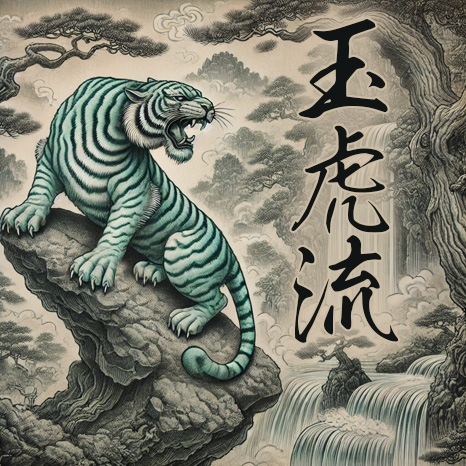Discover the Essence of Gyokko Ryu Kosshijutsu
Unveiling the Secrets of Ancient Martial Arts
The Legacy of Gyokko Ryu Kosshijutsu
Gyokko Ryū (玉虎流) forms part of the backbone of the martial arts we practice. This ryū-ha specializes in kosshijutsu (骨指術), shitōjutsu (指頭術), and ninjutsu (忍術). Founded by Tozawa Hakuunsai Hōgen (戸沢白雲斎, 1156–1159) during the Heian period (794–1192), Gyokko Ryū embodies principles that remain as relevant today as when they were first developed.
An interesting connection lies in the Gyokko Ryū makimono (scroll), where Togakure Ryū is written at the end. This inclusion has led some to consider Togakure Ryū as an extension of Gyokko Ryū. This interconnectedness highlights the depth and fluid evolution of these traditions within Japanese martial arts.
Several martial traditions evolved from Gyokko Ryū, including Koto Ryū and Togakure Ryū Ninjutsu. Practitioners are guided by the mindset of Banpen Fugyō (万変不驚), meaning “10,000 changes, no surprises.” This timeless philosophy emphasizes adaptability and composure, both on and off the battlefield.
The understanding of Gyokko Ryū’s teachings requires careful study, as the poetic and nuanced nature of the kanji used in its scrolls often allows for multiple interpretations. Variations in readings can alter the perceived meaning, making direct guidance from an experienced teacher essential for grasping the deeper layers of the art. Even native Japanese speakers may encounter challenges when interpreting these texts without proper context, emphasizing the importance of oral transmission alongside written study.
The techniques of Gyokko Ryū are performed with a relaxed yet explosive energy, supported by a strong structural foundation. This combination allows practitioners to execute movements with precision, efficiency, and adaptability, reflecting the enduring strength and practicality of this ryū-ha.
Core Techniques of Gyokko Ryu Kosshijutsu
The Gyokko Ryū Kosshijutsu curriculum is traditionally divided into distinct levels, each offering a progressively deeper understanding of the ryu’s techniques, strategies, and principles. These levels—Joryaku no Maki, Churyaku no Maki, and Geryaku no Maki—provide a structured path to mastery, beginning with foundational skills and advancing to more sophisticated applications. Before delving into these levels, practitioners must first develop a strong command of the kihon (fundamentals), which serve as the essential building blocks for all techniques within the ryu.
Kihon Gata (基本型) – "Fundamental Patterns"
The training in Gyokko Ryū Kosshijutsu begins with mastering its kihon, or fundamental techniques, which are practiced extensively to develop precision, body mechanics, and structural integrity. These kihon serve as the framework for all higher-level techniques in the ryu.
Taihenjutsu (体変術)
- Hira No Kamae (平の構え)
- Ichimonji No Kamae (一文字の構え)
- Jumonji No Kamae (十文字の構え)
Kamae Gata (構え型)
- Migi Ichimonji No Kamae (右一文字の構え)
- Hidari Ichimonji No Kamae (左一文字の構え)
- Hidari Hicho No Kamae (左飛鳥の構え)
- Migi Hicho No Kamae (右飛鳥の構え)
- Jumonji No Kamae (十文字の構え)
Torite Kihon Gata (捕手基本型)
- Ipponme (一本目)
- Nihonme (二本目)
- Sanbonme (三本目)
- Yonhonme (四本目)
- Gohonme (五本目)
- Ropponme (六本目)
- Nanahonme (七本目)
- Happonme (八本目)
- Kyuhonme (九本目)
- Jupponme (十本目)
Joryaku no Maki (上略の巻) – "Scroll of Higher Strategy"
The Joryaku no Maki introduces the fundamental principles and movements of Gyokko Ryū. This level focuses on teaching foundational body mechanics (taisabaki), posture, distancing, and angling to exploit an opponent's vulnerabilities. Practitioners learn how to remain relaxed while executing powerful, precise strikes targeting the muscles, nerves, and soft tissues (kosshijutsu).
Joryaku no Maki (上略の巻)
- Koku (虚空)
- Renyo (輦輿)
- Danshu (弾手)
- Danshi (弾指)
- Gyaku Nagare (逆流)
- Keo (鳧鷗)
- Hanebi (跳火)
- Keto (闕倒)
- Yubi Kudaki (指砕)
- Ketsumyaku (締脈)
- Sakketsu (殺締)
- Teiken (蹄拳)
Churyaku no Maki (中略の巻) – "Scroll of Middle Strategy"
The Churyaku no Maki expands on the foundational skills taught in the Joryaku no Maki by introducing intermediate techniques and strategies. This section contains techniques for defense against a kodachi (short sword).
Churyaku no Maki (中略の巻)
- Ujaku (烏鵲)
- Seito (鯖倒)
- Dashin (拏振)
- Koraku (虎落)
- Hosen (蜂先)
- Hane Tsurube (撥釣瓶)
- Shien (獅猿)
- Horaku (崩落)
Geryaku no Maki (下略の巻) – "Scroll of Lower Strategy"
The Geryaku no Maki focuses on advanced techniques and strategies designed for combat scenarios requiring precision and adaptability. This section contains techniques for defense against a daitō (long sword).
Geryaku no Maki (下略の巻)
- Shunu (隼雄)
- Shunsoku (隼足)
- Ichigeki (一撃)
- Kaisoku (魁足)
- Koryaku (掬掠)
- Iaifu (意合封)
- Chingan (沈雁)
- Fuu (風孟)

Learn Gyokko Ryu Joryaku No Maki
Training is available online directly from James Wright Kancho at Kobukan University.
